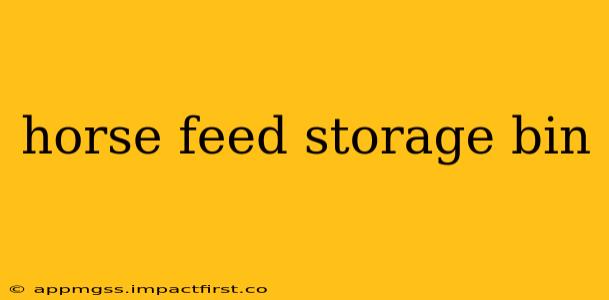Storing horse feed properly is crucial for maintaining its quality, preventing spoilage, and ensuring the health of your equine companions. A dedicated horse feed storage bin offers the best solution, protecting your valuable feed from pests, moisture, and the elements. But with so many options available, choosing the right bin can be overwhelming. This guide will walk you through everything you need to know about selecting and using a horse feed storage bin, answering many common questions along the way.
What are the different types of horse feed storage bins?
Horse feed storage bins come in various materials, sizes, and designs to suit different needs and budgets. Popular options include:
-
Plastic Bins: These are lightweight, relatively inexpensive, and easy to clean. They are often available in various sizes and may include features like lids and wheels for easy mobility. However, they can be susceptible to cracking under extreme temperature changes or if dropped.
-
Metal Bins: Metal bins, usually made of galvanized steel or stainless steel, offer superior durability and protection against rodents. They are more resistant to damage and can withstand harsher conditions. However, they are typically heavier and more expensive than plastic bins.
-
Wooden Bins: Wooden bins can provide a rustic aesthetic, but require more maintenance to prevent rot and infestation. They're often less weather-resistant than plastic or metal options.
-
Concrete Bins: These are highly durable and pest-proof but are expensive, difficult to move, and require professional installation. They're often seen on larger farms or commercial operations.
How much storage capacity do I need?
The size of the bin you need depends entirely on the number of horses you have, their feed consumption rate, and how frequently you purchase feed. Consider factors like:
- Number of horses: More horses require a larger storage capacity.
- Feed type: Some feeds are denser than others, impacting the overall volume.
- Feeding schedule: Daily feeding requires less storage than weekly or monthly feeding schedules.
- Feed delivery frequency: Frequent deliveries may allow you to use a smaller bin.
How do I keep pests out of my horse feed storage bin?
Pest control is paramount to maintain feed quality and prevent contamination. Effective strategies include:
- Airtight seal: Ensure your bin has a tight-fitting lid to prevent access for rodents and insects.
- Regular cleaning: Regularly clean the bin to remove spilled feed and debris that can attract pests.
- Pest repellent: Consider using natural pest repellents such as peppermint oil or diatomaceous earth (always check for safety with your horses first).
- Location: Store the bin in a cool, dry, and well-ventilated area away from potential entry points for pests.
What is the best way to organize my horse feed storage bin?
Organizing your feed storage can improve efficiency and prevent mix-ups. Consider these techniques:
- Labeling: Clearly label each bag or container of feed with its type, date of purchase, and expiration date.
- Stacking: Use sturdy shelving or racks to stack bags efficiently and maximize space.
- First-in, first-out (FIFO): Use the oldest feed first to minimize spoilage.
How do I maintain my horse feed storage bin?
Regular maintenance is crucial to prolong the lifespan of your storage bin and ensure feed quality. This includes:
- Cleaning: Regularly sweep or vacuum out spilled feed and debris. For thorough cleaning, use a mild detergent and water solution.
- Inspection: Regularly inspect the bin for any signs of damage, leaks, or pest infestation.
- Repair: Address any damage promptly to prevent further deterioration.
Where should I place my horse feed storage bin?
Choosing the right location is vital for protecting your feed and ensuring easy access. Factors to consider include:
- Accessibility: The bin should be easily accessible for filling and accessing feed.
- Protection from the elements: Store the bin in a sheltered area protected from rain, snow, and extreme temperatures.
- Pest control: Avoid placing the bin near potential pest harborages.
- Safety: Place the bin in a location that is safe and secure, away from potential hazards.
By carefully considering these factors and employing the tips above, you can select and utilize the ideal horse feed storage bin, safeguarding your horse's health and ensuring the quality of their feed for years to come. Remember to prioritize safety, cleanliness, and effective pest control for optimal results.
